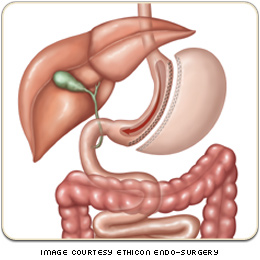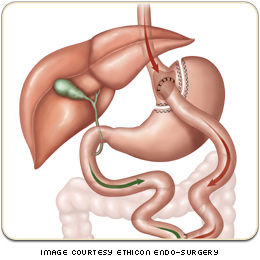 |
Good Evening, Today is November 21, 2024 |
|
Bariatric Surgery ProcedureDr. Attia and the ESA NJ team offer three major bariatric surgery procedures to those suffering from obesity and its related diseases in southern New Jersey. Bariatric surgery has proven to be effective in the long-term management and/or elimination of type-2 diabetes, high cholesterol, high blood pressure and sleep apnea to name a few.
|
Gastric bypass works by using both restrictive and malabsorptive techniques to allow for extreme weight loss. The restrictive part of the procedure reduces the amount of food the patient can consume at any given time by cutting away approximately 80% of the existing stomach. This leaves a small gastric pouch as the primary receptacle for the food that is consumed. This pouch, which is not much larger than a golf ball, restricts the amount of food that can be eaten and allows the patient to feel fuller sooner.
The second part of the procedure is the bypassing of a large portion of the small intestine. In doing so, fewer calories are able to be absorbed into the bloodstream through the intestinal walls meaning that the patient will lose weight. The combination of both the restrictive and malabsorptive features of this procedure allow for the greatest weight loss of any bariatric surgery procedure currently available.
Advantages of Gastric Bypass Include:
- Exceptional weight loss and disease resolution potential – more than any other surgical weight loss procedure.
- Minimally invasive surgery means that hospital and recovery times are shorter and complication rates are reduced.
- A medical device will not be implanted in the abdomen such as with the gastric band.
Risks Include:
- Development of uncomfortable but not life-threatening dumping syndrome when high fat or high sugar foods are consumed.
- A patient will need to remain on nutritional and vitamin supplements for the rest of their lives.
- This procedure is major surgery and comes with inherent surgical risk.
- Gastric bypass is not reversible.
- The staple line may leak requiring immediate emergency attention.
 Gastric Sleeve
Gastric Sleeve
Gastric sleeve surgery was once used as the first part of a two-part procedure; the second usually being a gastric bypass or duodenal switch. However, through the years, weight loss surgeons saw how effective the gastric sleeve was as a standalone procedure. Today it has become a very popular surgery that offers excellent weight loss and disease resolution potential with minimized risk.
How It Works
The gastric sleeve procedure involves cutting away and removing about 70% to 75% of the existing stomach pouch along the greater curvature. This forms the remaining stomach into a sleeve, about the size and shape of a banana, which restricts the amount of food that can be consumed at any given time. The much reduced sized stomach means that the patient will feel fuller sooner and will, in turn, lose weight. During the gastric sleeve procedure, unlike gastric bypass, the separated part of the stomach does not remain in the abdomen and the small intestine is not bypassed.
Advantages of the Gastric Sleeve Include:
- Gastric sleeve patients will lose significant amount of weight and most of the diseases associated with obesity will be improved resolved after surgery.
- The gastric sleeve does not reroute the intestine, therefore food restrictions are not as severe as gastric bypass.
- Laparoscopic (minimally invasive) surgery means that hospital and recovery time is reduced significantly over an open procedure.
- A medical device will not be implanted in the abdomen such as in gastric banding.
- Removing the majority of the stomach along the greater curvature eliminates the fundus which produces the hunger hormone called ghrelin. This may lead to fewer hunger pangs.
Risks of the Gastric Sleeve Include:
- It is not reversible although it can be converted into a gastric bypass if it does not offer its full weight loss potential.
- Gastric sleeve is major surgery and comes with inherent risks of surgery
- Gastric sleeve patients will need to take vitamin and mineral supplementation now and possibly for the rest of their lives.
- The staple line may leak, requiring immediate emergency attention.
|
• Home • About Us • Pathway to Surgery • Bariatric Surgery • General Surgery • FAQ • Contact Us
All Content ©2011-2022 ESA South Jersey Bariatrics 1103 W. Sherman Avenue, Bldg. 2 Unit C • Vineland, NJ 08360 • Phone: (856) 362-5259 • Web Site Design Florida |
 Gastric Bypass
Gastric Bypass